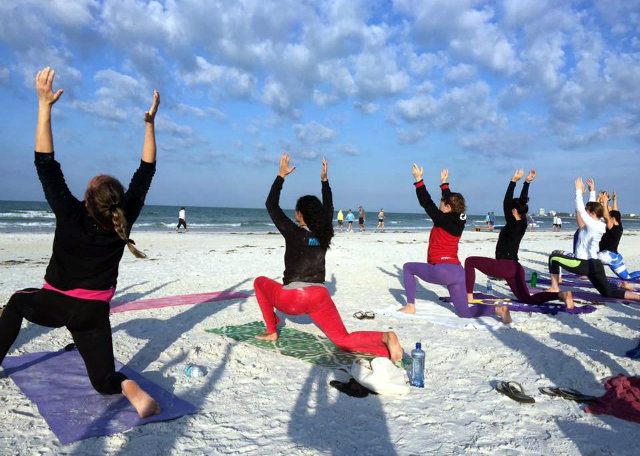
Life is full of ups and downs. All of us at one stage or another go through challenging times. This is life. But it is important not to get too overwhelmed or fueled with chronic anxiety over situations that can eat away at our mental and physical health.
Chronic stress and anxiety elevate the body’s cortisol level. Living in this state basically encourages our bodies to use our hard-earned muscle for energy and to store fat more efficiently. Chronic stress also lowers our immune system and makes us more susceptible to illness. Anxiety, stress and negative emotions directly affect our health and wellbeing.
For me — having dealt with divorce, serious injuries that have taken me out of big championships, illnesses, and other losses — I have found that one of the best methods to deal with serious challenges was to put myself in the present moment as much as possible. Too often, we worry about things that haven’t happened yet or we fixate on things from the past. But if we are completely in the present moment, then there is no future and no past to stress about, right?
Taking each day at a time or each moment at a time is the best recipe to mitigate feelings of loss, stress, worry, regret, and anxiety. Easier said than done, though, I know.

When we’re told to “be present,” the first place our minds typically go is thoughts like:
- “What if I don’t have the money to pay my rent next month?”
- “I am terrified of flying because the last flight had so much turbulence!”
- “The pain my back is almost unbearable!”
These are all legitimate reasons to feel out of sorts, but the trick is to not let these things dictate our lives to the point we are consumed with worry and stress that can impact our health.
The key to the solution is this: we have a choice in how we deal with challenges in our lives.
Worrying, for example, is a state we choose, whether we realize it or not. But putting ourselves in the present moment switches us from worry to just being, since worry is a state that happens when we are caught up in the future or the past. This is especially important when we are dealing with situations we can’t control. If you stop, right now, where you are, you can choose to just be without those worries.
Okay, so again, I know that’s easier said than done — trust me. Just as I learned that being present helped me through my personal challenges, I also learned some strategies in how to be present. So, here are three of my favorite ways that we can easily put ourselves in the present moment.
1. Physical Activity
Getting in a great workout is a wonderful way of putting yourself in the present. You could do some kickboxing, take a challenging CrossFit class, or learn new techniques on the mat in Brazilian jiu jitsu.
But if group classes aren’t your thing, then hitting the gym and lifting some weights is another great way to put yourself in the moment. Aim for a workout that is challenging enough to keep your mind on the exercises. You should be focused on maintaining good form while pushing through the last few reps. Set small goals to stay focused. If you usually do ten reps, then aim to do twelve reps. After you have pushed yourself through twelve, you will not only feel good about yourself, but over time you will reap the physical rewards, as well.
Another way to stay focused is to switch your cardio from a slow-and-steady run to some interval training. Because how often do our minds wander during cardio? That is the “perfect” time to dwell on things and go further into the rabbit hole of depressing and stressful thoughts. By increasing the intensity of your cardio and constantly switching things up, your mind will stay focused on the task at hand in order to get through it.

Training Brazilian jiu jitsu helps me find the present moment.
Whether you are running, cycling, or rowing, I recommend trying one minute at an easy pace and then one minute at a challenging pace. If you are a runner, maybe switch from a walk to a fast jog or a sprint every minute. Not only will this keep you in the present moment, but it will whip you into shape in no time. Circuit training where you move from one exercise to the next without much rest in between, is another great way to stay focused on the activity and to achieve an effective workout at the same time.
Whatever the activity or workout may be, since we are so focused on our mission, we end up completely in the moment. And if we are in the present moment, then we can’t dwell on the past or worry about the future, right?
My simple advice is this: hit the gym or go to a class, challenge yourself, and set some small personal goals. Once you work up a sweat, you won’t be stressing about the events in your life. Also, you will finish your workout full of all those “feel good” endorphins you’ve released into your body. In addition, with all those focused workouts, you will be feeling amazing physically, as well, which we all know also supports a positive mental state.

2. Meditation
Meditation allows us to clear our mind by eliminating all the mental chatter, the unnecessary worry and the stress. I personally think meditation is the best way reach a state of peace in the present moment, but it does take practice.
Our brain operates on brain waves that have different frequencies depending on which state we are in. Brain waves are measured in cycles per second or Hertz (Hz). When the brain activity is slow, the number of Hz is lower.1 For example:
- Delta waves are below 4Hz and occur during sleep
- Theta waves are between 4-7Hz and are associated with sleep, deep relaxation (like hypnotic relaxation), and visualization
- Alpha waves are between 8-13Hz and occur when we are relaxed and calm
- Beta waves are between 13-38Hz and occur when we are actively thinking or problem-solving.
When we are awake and going about our day, our brains are usually operating in beta waves. While we sleep, the brain shifts to low-frequency delta waves. While we meditate, our brains are in a state of predominantly alpha waves and some theta waves. Studies have shown that the alpha and theta brainwave states achieved during meditation make a person more relaxed and calm, but also still aware and alert.2 This is a different state from feeling sleepy. The brain is focusing during meditation, but it is a calm and steady focus. This allows for the mind to quiet and the body to relax to achieve a still state, not a sleepy state.

There are many different methods of meditation but the simplest way to reach this peaceful state is to focus entirely on the body and breath. This practice is known as “mindful meditation” or “focused attention.” Our breath is one of the few things in our body that is autonomous, i.e. that we can actually control. Breathing happens when we don’t think about it, thank goodness, but we can also breath while thinking about it. Purposeful breathing is extremely useful to calm our bodies in stressful situations. It is also one of the best ways to begin a meditation practice, by being aware of our breathing and focusing on each inhalation and exhalation.
Here’s how to do it:
- Start by finding a comfortable place to sit or lie down without being distracted.
- Close your eyes and inhale slowly for a count of six to eight. Then exhale slowly for a count of six to eight.
- When you inhale, imagine you are breathing in clean light air or energy, and when you exhale, imagine you are releasing dark air or energy that your body needs to clear.
- Keep this focus on the breath while trying to relax every part of your body. Visualize moving down your body from the top of your head down to the tips of your toes. As you move through each part of your body, allow for the relaxation to set in, specifically taking advantage of each exhale to further relax your muscles.
- Enjoy the stillness. If a stray thought comes into your mind, push it out by returning your focus to your breath or to the relaxed muscles in your body. Every time a thought comes into your mind, replace it as soon as you are aware of it.
Deep, calm, and purposeful breathing and meditation have been shown to relax your body by calming your central nervous system (which can be over-activated from chronic anxiety and stress). Meditation has been shown to calm the sympathetic nervous system specifically, and also allows the parasympathetic nervous system to activate to repair any damage caused to the body by stress and to restore the normal functionality of the whole body. Reducing stress via meditation also means lowered cortisol levels, lower blood pressure, increased immune function, and increased mental well-being.3
Meditation can feel awkward and hard at first, and it does take practice. But just like training the body, the more you do it, the easier it becomes to stay focused. Progress can be measured by how long a single thought can be focused upon without straying. It is worth the effort, though — the benefits of finding time to meditate even only for fifteen minutes a day are astounding for both the body and the mind.
3. Active Meditation
I mentioned that physical activity is a great way to put yourself in the present moment, so for those of you who have trouble sitting still and find the idea of classic meditation unappealing, you might try “active” meditation instead. A movement-based approach to meditation can put your mind into a state where you are clear of mental chatter, completely focused on the task at hand, and in the present moment.

The women at my lifestyle camp practice yoga together.
Yoga is a great example of active meditation. Breathing while moving your body through the poses connects your mind and your body. If you are truly focusing on your movement and breath, then you become grounded in the movement and the moment. As a trainer, part of what I do is run lifestyle camps that focus on all aspects of health and fitness including the mental aspect. The ladies who attended my last camp all enjoyed sunrise yoga at the beach as a way to balance out other aspects of their lives and start each day in the present.
Some other forms of active meditation are: martial arts, swimming laps, jogging or walking, surfing, tai chi. Weight lifting can be a form of active meditation also. The key is to find the movement practice that helps you get into your flow, Zen, or peaceful state. Each of us will have different activities that do this for us.
Find Your Power in the Present Moment
Being in the present moment is an exceptionally powerful and simple way to deal with the challenges in our lives. Using these tools to get us into the present, such as deep breathing, active or passive meditation, or a great workout allows us to more effectively take control of the situation by taking things moment by moment and day by day.
Being in the present moment makes us aware that we have a choice in how we deal with our stressful situations. Worry and fear don’t have to be the only way we deal with things. Getting in a great workout or doing meditation also provides many other physiological benefits.
So try not to stress over the things you can’t control, hit the gym or find a quiet place to meditate, and reap the benefits — body, mind and soul.



































